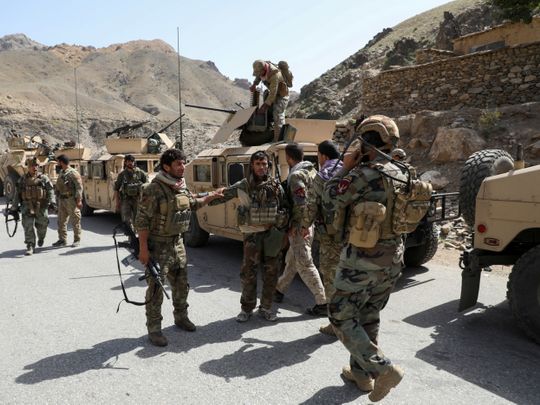
KABUL, Afghanistan: The top American military commander in Afghanistan expressed deep concern on Tuesday that the country could slide into a chaotic civil war and face “very hard times” unless its fractious civilian leadership unites and the haphazard array of armed groups joining the anti-Taliban fight are controlled and made “accountable” for their actions in battle.
The bleak assessment by General Austin Miller, who met with a group of journalists, came as Taliban forces continued their rapid advance across northern Afghan provinces and expanded into other rural regions. The insurgents also began circling closer to the capital city.
In the past several days, officials and Afghan media reported, Taliban fighters have overrun parts of three provinces, all just short drives from Kabul on highways running north and south. They also attacked security posts in a third area that hugs the city’s western border.
Miller, who has led the US military mission here since 2018, is overseeing the final drawdown of US forces that once numbered more than 100,000 during the 19-year conflict with Taliban extremists. He described the drawdown as going well “from a military standpoint” and said he expected it to finish on schedule. President Joe Biden ordered that all US forces leave Afghanistan by September 11.

But the general, whose mission was focused on training, motivating and improving the performance of Afghan security forces noted that the looming U.S. departure had damaged their morale, which he said already had been flagging after months of heavy fighting.
“The security situation is not good,” Miller said. He cited the widening loss of territory and rising government troop casualties amid a “countrywide offensive” by the Taliban that has been launched at the same time that peace talks are supposed to be taking place. “There are a lot of questions about why and how this is happening.”
140 of 370 districts under Taliban control?
By some experts’ estimates, Taliban forces control as many as 140 of the country’s 370 districts and are active or influential in 170 others. US and Afghan military officials alike have given much lower estimates, but more districts continue to fall to the Taliban almost daily, either in violent clashes or by peaceful surrenders, according to local officials and Afghan media reports.
In one set of attacks, the Taliban have seized two districts in Kapisa and Parwan provinces, both located on the highway between Kabul and the north, local officials said. Fighters also took over a town in Wardak province that straddles the highway leading south to Kandahar city. The Taliban released video footage on social media showing its fighters, wearing black turbans, strolling in the town and raising celebratory shouts.
“Their strategy is to surround the city as well as the provincial capitals, pushing closer and closer from all sides until they can stop, just short of entering Kabul, and say they are now ready to talk about peace,” Rahmatullah Nabil, a former national intelligence director, said in an interview this week. He also said the group is targeting other strategic spots, including some on the porous border with Pakistan, some containing mineral mines or dams, and others on rural link roads.
US support to armed forces
Last week, Afghan President Ashraf Ghani met with President Biden in Washington as US troops began to withdraw, a process that Biden announced in April would be completed by September11. Biden told him that the United States would continue providing financial aid to the government and support to the armed forces but that Afghans would have to “decide their own future.”
Biden gave no indication that the withdrawal period would be extended, despite appeals from some members of Congress and indications in US intelligence reports estimating that the Ghani government could fall within six to 12 months of a completed US troop withdrawal. Ghani barely won reelection in 2019, and his popularity has fallen steadily as the peace talks he championed have virtually collapsed.
Miller said on Tuesday that he expected the pullout to be completed on schedule, although he said he would be replaced before then. He stressed that for now he has “full authority” under a US-Taliban peace deal signed last year to provide armed support to Afghan ground forces, including US airstrikes. Afghan military commanders have repeatedly said that US air support is crucial to reversing recent gains by the Taliban.
He declined to say how many American forces would remain in the country after the withdrawal, but that it would be sufficient to provide security for US diplomats and other officials. The number is expected to be between 600 and 650.
Multi-faction civil war
But Miller’s assessment of the overall current conditions and future scenarios for Afghanistan was bluntly pessimistic. He said he was especially concerned that the country could spiral into a state of violence, leading to a multi-faction civil war, and that without proper controls, local militia groups now rearming and joining the anti-Taliban effort could revert to old ethnic vendettas and abusive battlefield behavior.
“A civil war path is visualizable,” the general said, warning that if violence escalates and atrocities occur, the country could “devolve” into a chaotic state, similar to what Afghans endured in the 1990s after the withdrawal of Soviet forces. He also placed partial blame on the Taliban, saying they had “failed to reduce violence” under the terms of their agreement with the United States.
Another obstacle to peace, he said, is the persistent discord and factionalism among Afghan government officials and members of the country’s political elite, leading to constant changes in policy and senior appointments, and weakening confidence among civilians and the security forces.
Miller did not comment directly on the likelihood that the Ghani government could collapse as soon as six months after the US troop withdrawal, but he said it was crucial for government officials and rival politicians to “unify” as the war intensifies and hopes for peace grow dim. Otherwise, he said, “I see very tough times ahead.”












